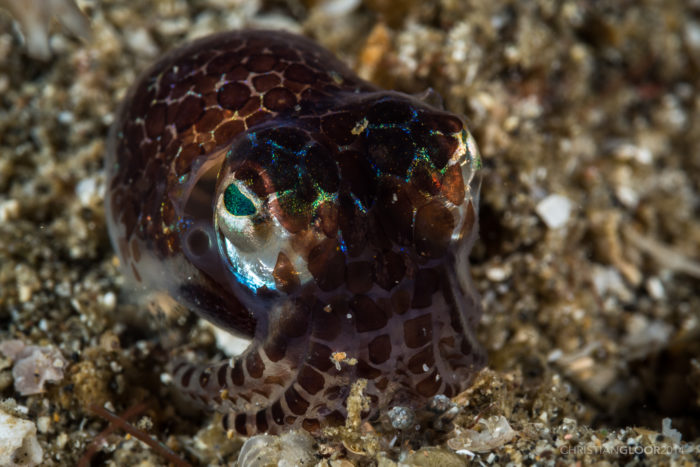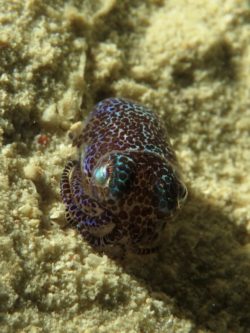
Sea Wonder: Bobtail Squid

Photo credit: Christian Gloor
Description
Hawaiian bobtail squid (Euprymna scolopes) is a marine invertebrate related to other species of squid, octopuses, cuttlefish, and chambered nautilus. This species is small, reaching a maximum size of about three centimeters long (about the size of a standard golf ball)! Their brains are enormous compared to their body size and they have large (for their bodies) paddle-shaped fins that help them swim through the water column. The Hawaiian bobtail squid is pear-shaped and mottled in color, which they can change with the help of organs called chromatophores. The species has a symbiotic relationship with bioluminescent bacteria (Vibrio fischeri) that take shelter in the squids’ mantles and allow the animals to (beautifully) camouflage itself from predators by hiding the squid’s silhouette and matching the amount of moonlight hitting the top of its mantle from the water’s surface. You might also see the Hawaiian bobtail squid covered in sand, which it does to camouflage itself when near the seafloor.
Diet & Habitat
Hawaiian bobtail squids are ambush predators that eat smaller shrimp and other crustaceans, but they’ve been observed eating small fish and annelids on occasion. The species is nocturnal, hunting from dusk until dawn, when their prey are less active and aware. During the day, bobtail squids hide, burying themselves in the sediment or hiding in nooks and crannies throughout their habitat.
Unlike many other bobtail squids that live in cooler or deeper waters, the Hawaiian bobtail squid lives in shallow coastal waters of the Pacific, including around the Hawaiian Islands. In the National Marine Sanctuary System, we can find these squids in and near Hawaiian Islands Humpback Whale National Marine Sanctuary and Papahānaumokuākea Marine National Monument.
Life History
The Hawaiian bobtail squid is short-lived, living only three to 10 months, growing and moving through its life stages quite quickly. The species reaches sexual maturity at around two months old and reproduces only once in a single lifetime. This squid leads a fairly solitary life, living near other individuals and generally interacting only for breeding. After females lay eggs on the underside of coral ledges, they die shortly after; males die almost immediately after fertilization.
Hatchlings emerge from their eggs a few days after fertilization, and a few days later reaches its juvenile stage. Hatchlings begin secreting a specialized mucus around their light organs, allowing them to attract their symbiotic bacteria almost immediately. This species is nocturnal and spends most of its daylight hours buried in the sand. Each morning, Hawaiian bobtail squids vent 90 percent or more of the bacteria living in their mantles back into the water column, replenishing them during the day, and by evening, the squid has a new crop of bacteria to help it camouflage.
Threats & Conservation
Since the Hawaiian bobtail squid is short-lived, we don’t know much about its population status or health. As a result, there are no special legal protections offered to the species. Hawaiian monk seals are their primary predators, with larger fish, sharks, and other marine vertebrates also feeding on these tiny morsels.
Future threats to Hawaiian bobtail squids are warming ocean waters, ocean acidification, marine pollution, and coastal development.

Photo credit: Daniel Kwok
